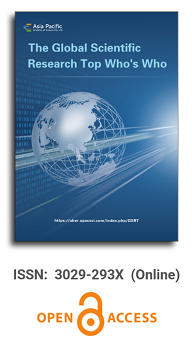|
|
||
About This Journal
Focus and ScopeThe Global Scientific Research Top Who's Who is designed to encourage and recognize those who are making and have made contributions to the advancement of science. Included scholars should have an outstanding scientific research level, sufficient scientific research vision, and beneficial social influence. For Authors
Article Processing Charges (APCs)The Global Scientific Research Top Who's Who aims to encourage and recognize research scholars. We are in the process of applying for an ISSN to publish and keep it in the permanent collection of the Singapore Library, and we will not charge you any APC fees. The Global Scientific Research Top Who's Who will be published online and in paper form, and we will also publish issue collections and present honorary medals for each included research scholar (you will be personally responsible for the production cost of $99). APC PaymentPayments for APC of this journal can be made through our online PayPal payment gateway. Enter the article no. into the below textbox and select "Pay Now" to proceed with payment. *Article No. is mandatory for payment and it can be found on the acceptance letter issued by the Editorial Office. Payment without indicating Article No. will result in processing problem and delay in article processing. Please note that payments will be processed in USD. You can make payment through Masters, Visa or UnionPay card. |
Latest Articles
by
Rufeng Zhang, Tingting Hou, Heping Cheng, Xianhua Wang
2023,
1(1);
Abstract
Mitochondria are fundamental organelles for cellular and systemic metabolism, and their dysfunction has been implicated in the development of diverse metabolic diseases. Boosted mitochondrial metabolism might be able to protect against metabolic stress and prevent metabolic disorders. Here we show that NADH: ubiquinone oxidoreductase (NDU)-FAB1, also known as mitochondrial acyl carrier protein, acts as a novel enhancer of mitochondrial metabolism and protects against obesity and insulin resistance. Mechanistically, NDUFAB1 coordinately enhances lipoylation and activation of pyruvate dehydrogenase mediated by the mitochondrial fatty acid synthesis pathway and increases the assembly of respiratory complexes and supercomplexes. Skeletal muscl e–sp ecific ablation of NDUFAB1 causes systemic disruption of glucose homeostasis and defective insulin signaling, leading to growth arrest and early death within 5 postnatal days. In contrast, NDUFAB1 overexpression effectively protects mice against obesity and insulin resistance when the animals are challenged with a high-fat diet. Our findings indicate that NDUFAB1 could be a novel mitochondrial target to prevent obesity and insulin resistance by enhancing mitochondrial metabolism.
show more
by
Bo Tan, Fan Yang
2023,
1(1);
Abstract
The Marching Cube method, a classical algorithm based on the voxel method, is used to perform three-dimensional computer-aided dance movements. Aiming at several problems in the MC algorithm, an optimization and improvement method is proposed, which realizes the organic combination of image segmentation and the MC algorithm. We use the segmented binary data to extract the isosurface; solve the ambiguity problem by establishing a look-up table of intersection conditions; use the method of quickly finding the boundary cube to avoid searching for a certain amount of empty cells; at the same time, use the midpoint method to calculate the triangle vertices. This paper verifies the effectiveness of the dance action recognition algorithm proposed in this paper on the dance data set DanceDB of the University of Cyprus and the folk dance data set FolkDance produced by the laboratory. The experimental results show that the algorithm in this paper can maintain a certain recognition rate for more complex dance movements, and the method in this paper can still guarantee a certain accuracy rate when the background and the target are easily confused. This also verifies the effectiveness of the motion recognition algorithm in this paper for dance motion recognition.
show more
by
Gan He
2023,
1(1);
Abstract
Examination-directed and book-centered education in primary and secondary schools left a strenuous task—enculturation of students. Is it possible for higher education to fulfill the unfinished job? First, the article argues that education today forecasts the future of a nation, and combining enculturation with lectures in the colleges and universities becomes inevitable. Second, it explores the approach of enculturation through a reading course in the university.
show more
by
Daniela Saetta, Luigi Bellante, Maria Vittoria Lacaita, Maria Ernestina Faggiano, Daniela Scala, Valentina Franzoni
2023,
1(1);
Abstract
In recent years, the field of Narrative Pharmacy was introduced, which particularly addresses the pharmacist not only to guide a relationship of listening to and caring for the patient but also to strengthen and motivate toward the profession, improve relationships with colleagues, enhance the ability to teamwork, and understand emotions. In this paper, we report the analysis behind the construction of the Value Chart from the personal narratives of members of the Italian Society of Hospital Pharmacy. Each member’s subjective professional experiences and their own view of themselves within society were collected through a semi-structured interview. Personal thinking, including experiences, feelings, opinions, desires, and regrets was classified by objective methods, from which main concepts were extracted for the Value Chart. The feedback to the survey, including activities during the Covid-19 pandemic management, is classified according to the analytical methods of Kleinman, Frank, Bury and Launer-Robinson. Regarding sentiment analysis, the emotional and subjective context of the text provides an ideal baseline to validate the result. The analysis was implemented using neural networks trained on dictionaries and natural language (i.e., Tweets). The originality of the work lies in the fact that generally value charters are built on a Society’s values. In contrast, in this case, individual contributions were gathered to complement the ethical values on which the society is founded.
show more



 Open Access
Open Access